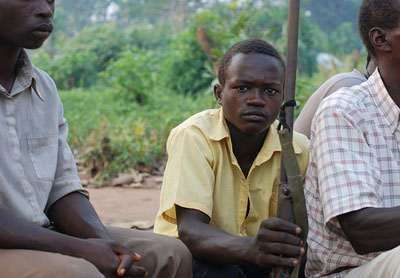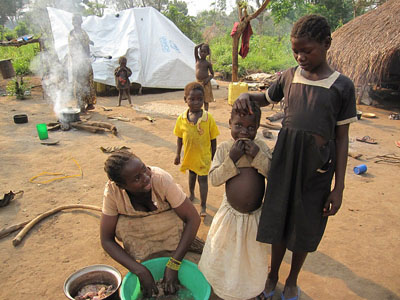
YAMBIO, Western Equatoria, Southern Sudan—
“Omar Bashir,” Adrian said, emphatically responding to the question we posed to our local interpreter without waiting for the Zande translation. We had asked who he thought was behind the recent attacks by the Lord’s Resistance Army, or LRA, on his community in southern Sudan. “They have been sent. They have been bribed, told to kill the people on this land,” he said. Eight months ago, this 23-year-old—his youthful face hiding the horrors he has witnessed—fled with many others from his village to the largest town in this remote corner of southern Sudan near the Congolese border. Adrian and his fellow villagers now live on land owned by the local Episcopal Church, and have begun building basic homes and cultivating the land.
But after speaking to Adrian and other men in this makeshift village of displaced and traumatized survivors of LRA attacks, it’s clear that they don’t plan to simply wait out the storm. In the absence of an effective response by the Sudanese government to the LRA, many local men and boys have taken community security into their own hands. They are part of a loose-knit, meagerly armed, local defense force called the Arrow Boys.
The Enemy
The LRA is a brutal, predatory militia that originated in northern Uganda in 1986 and has terrorized civilian populations across central Africa ever since. In December 2008, a U.S.- backed military operation by the governments of Southern Sudan, Democratic Republic of the Congo, and Uganda, known as Operation Lightning Thunder, attempted to destroy the LRA’s command center based at the time in Garamba National Park in northeastern Congo. Since this offensive, the LRA has moved north from Garamba, fanning out across the dense forests of northeastern Congo, Sudan’s Western Equatoria state, and neighboring Central African Republic. Credible reports by the Ugandan and southern Sudanese armies suggest that members of the LRA are taking refuge (and seeking to resupply) in South Darfur.
The International Criminal Court issued arrest warrants for the LRA’s messianic leader Kony and two of his commanders for crimes against humanity, but they remain at-large. Anecdotal evidence suggests that the historic link between the LRA and the ruling National Congress Party in Khartoum, thought to have tapered off in recent years, may have been revived. In the minds of Adrian and many of the rank-and-file Arrow Boys operating in southern Sudan, there’s no doubt of this connection.
Enough’s LRA researcher Ledio Cakaj recently documented the failures of the SPLA and the United Nations Mission in Sudan, to protect civilians in Western Equatoria, where a string of ongoing LRA attacks displaced more than 80,000 Sudanese people in 2009. Decentralized and on the move, the LRA has been particularly lethal in recent months, with little standing in their way – except civilian populations. “They are even more dangerous now that they are in small groups,” said Sister Giovanna, an Italian nun in the town of Nzara (20 kilometers from Yambio) who lived in northern Uganda during the height of the LRA violence there.

Mobilizing, Seeking Support, and Taking Action
The concept behind the Arrow Boys preceded the LRA’s most recent arrival in Sudan. Originally, the Ugandan government, seeing its shortcomings in combating the LRA, supported the creation of the Arrow Boys in northern Uganda to protect the local communities, particularly vulnerable camps of displaced people. The title of this local militia came from the primary weapon used by its members. (Watch for an upcoming blog post on the history of the Arrow Boys in Uganda.)
In southern Sudan, the Arrow Boys seem to have sprung up more spontaneously.
The regional leader of the Arrow Boys, who asked for his name not to be used for security reasons, explained that after watching the LRA ravage their communities, southern Sudanese men and boys decided to respond.
“Very many people have died, and many others have had to flee their homes. […] We came with the mind of how to provide security for those that are here and end that threat [of the LRA],” he said.
“When I saw that kind of killing—they could crash the heads of your sons and daughters so they can’t even be recognized—it pained my heart,” said the leader of one group of Arrow Boys. “It depends on the heart. Any boy can be an Arrow Boy,” he said.
Having logged some victories against the LRA and won the support of their local communities and churches, the Arrow Boys turned to the government of Western Equatoria State for endorsement. As a show of solidarity, church leaders and government officials, including Western Equatoria governor Jemma Kumba, participated in a march in September 2009 to raise awareness about the LRA threat in the state. Their protest generated national and international attention, and the Government of Southern Sudan, or GoSS, pledged to send additional troops to fend off the predatory militia and defend the local population. But, attacks have continued. Since then, the government has stayed engaged with the Arrow Boys, though the nature of its support remains ambiguous. Some Arrow Boys Enough spoke to claimed that they have received bullets from Sudanese soldiers from time to time, but local and state government officials insist that they are not arming the Arrow Boys; rather, the government has given them permission to operate and convinced GoSS to postpone a scheduled civilian disarmament campaign in Western Equatoria so that its civilians can continue to defend themselves.
Local government sources frame the Arrow Boys as part of an organized counterinsurgency strategy. Col. Joseph Ngere, the Deputy Governor and Minister of Information in Western Equatoria, credited the Arrow Boys with being well placed to produce intelligence for the government. “In terms of information collection, it is not possible to have the army on every border,” Col. Ngere said. “The Arrow Boys know the land well so they should help.” Yambio County Commissioner David Billy reinforced this perspective. He was complimentary of their contribution to the fight but maintained that the Arrow Boys are “not given the power to do things by themselves. They are not engaging on the front line.”
However, visiting areas recently targeted by the LRA, neither the Arrow Boys nor members of their communities gave the impression that their fathers, sons, and brothers are simply feeding information to the army and clearing the way for the Sudanese soldiers to confront the militia. While coordination between the SPLA and the Arrow Boys would almost certainly bolster civilian protection in Western Equatoria, it seems that this collaboration has yet to be fully optimized.

Creative Community Security Measures
With their local guns that shoot only one bullet before needing to be reloaded and their handmade bows and arrows, the Arrow Boys may not seem to be militarily matched to the LRA and their sophisticated weapons. What the Arrow Boys have on their side, though, is the ability to counter one of the LRA’s primary tactics: surprise. The LRA doesn’t expect any resistance, they don’t expect people to fight back,” said an employee of an international organization working in Western Equatoria. Using a system that resembles a neighborhood phone tree, the Arrow Boys stay connected through cell phones dispersed strategically among the leaders of their ranks. They quickly mobilize to reinforce their comrades when the LRA is spotted in the area.
Another advantage that the Arrow Boys use to better protect their communities is their knowledge of the area. Given their familiarity with the terrain, the Arrow Boys can predict which routes the LRA will take and stake them out, capturing or killing LRA who fall into their ambush. In one area Enough visited, groups of 15-20 Arrow Boys take turns conducting nightly patrols, arguably the most important practice of protecting civilians from the LRA. The Arrow Boys and their sympathizers also keep in close touch with both southern Sudanese and Ugandan army contacts in the region. “I never thought a cell phone could be so useful. Thank God that Zain [cell network] is here now,” said Sister Giovanna, underscoring the tremendous impact basic technology can have on grassroots, civilian protection.
The regional leader of the Arrow Boys described how his group coordinates with village leaders to keep track of the people who come and go. They can gauge the approximate location of the LRA based on information from displaced people who arrive from sites of fresh LRA attacks. In partnership with village elders, the Arrow Boys also spread information about the tactics of the LRA so that local communities can do their best to remain alert and attempt to avoid succumbing to ploys the LRA use to gain access to the communities. One known maneuver is pretending to surrender – a tactic that recently led to the death of five civilians in a village we visited.
Local Security or a Budding Militia?
“We support them, but the idea is not to create another militia,” said the deputy governor of Western Equatoria. “The Arrow Boys are under our control,” said County Commissioner Billy.
The men and teenage boys we interviewed in displaced persons settlements and on the outskirts of insecure villages that have seen multiple LRA attacks do not resemble hardened militiamen or battle-ready soldiers. They are mainly farmers in an area that saw little fighting during the violent North-South civil war in Sudan. The Arrow Boys insist that they will disband as soon as the threat of the LRA subsides in their own communities. “We have only one plan, which is to provide security just here, because it is very hard for us to continue following [the LRA],” said the regional Arrow Boys leader. They don’t have the resources or the organizational structure to pursue the LRA farther afield, he said, acknowledging reports that the LRA may be moving north toward Darfur. “What we normally do is just to keep security here tight and provide a defense system to our own people.”
But as the scope of the Arrow Boys’ operations expand to include other policing duties, like rounding up local drunkards and troublemakers, and the public perception of a southern Sudanese government unable or unwilling to confront the LRA threat persists, the Arrow Boys seem to be making themselves increasingly indispensable. Should some sub-group or powerful local leader within the Arrow Boys decide that the group should broaden its mandate and extend its existence beyond the horizon of the LRA threat, many complicated questions will arise. Who will attempt to disband and disarm the Arrow Boys (and how)? What will the impact be of the dissolution of the Arrow Boys—largely made up of men and boys who may have found ways to profit from their membership in this group, and who may be reluctant to relinquish their status as defenders of their communities?
Apart from the LRA violence, we heard much talk of tension in Western Equatoria state between the agrarian Azande people and the cattle-keeping Dinka and Mbororo groups. “It is the other small sickness, the virus, in southern Sudan,” said Adrian, reflecting on just one of the numerous, deep internal ethnic fissures in southern Sudan. Whether the LRA moves away from Western Equatoria on its own volition, or the Arrow Boys help to push the LRA out of this territory, one can already anticipate a possible future source of instability – indeed, so-called ‘tribal clashes’ killed more than 2,500 people last year in other parts of southern Sudan. Given the history of proxy warfare in Sudan, it’s not difficult to imagine how the government in Khartoum might exploit these local rivalries following the exodus of the LRA from the region.

